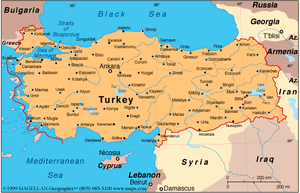Iris: Difference between revisions
No edit summary |
(→Course) |
||
| (3 intermediate revisions by the same user not shown) | |||
| Line 1: | Line 1: | ||
{| class="wikitable" style="text-align:center"; border="5" | |||
|align=center colspan=13 style="background: #FFD700"| <small>''' Author:[[User:Lrburdak|Laxman Burdak]], IFS (R) '''</small> | |||
|- | |||
|} | |||
---- | |||
[[File:Turkey Map1.gif|thumb|Map of Turkey]] | |||
'''Iris''' was an ancient river in northern [[Turkey]]. Presently it is called the [[Yeşilırmak]] (Turkish: Yeşilırmak 'Green River'. | '''Iris''' was an ancient river in northern [[Turkey]]. Presently it is called the [[Yeşilırmak]] (Turkish: Yeşilırmak 'Green River'. | ||
== Variants == | == Variants == | ||
* Iris: Ancient Greek Ἶρις | * Iris: Ancient Greek Ἶρις | ||
*[[Iris River]] | |||
*[[Yeşilırmak]] (Turkish: Yeşilırmak 'Green River' | *[[Yeşilırmak]] (Turkish: Yeşilırmak 'Green River' | ||
== Course == | == Course == | ||
| Line 8: | Line 15: | ||
Its tributaries include the Çekerek (ancient Scylax) and the Kelkit (ancient Lycus). | Its tributaries include the Çekerek (ancient Scylax) and the Kelkit (ancient Lycus). | ||
It was mentioned by Menippus of Pergamon in the 1st century BC.[ | It was mentioned by Menippus of Pergamon in the 1st century BC.<ref>Serena Bianchetti, Michele Cataudella, Hans-Joachim Gehrke, [Brill's Companion to Ancient Geography: The Inhabited World in Greek and Roman Tradition (BRILL, 4 Dec 2015) p 263.</ref><ref>Georgia L. IrbyGeorgia L. Irby, A Companion to Science, Technology, and Medicine in Ancient Greece and Rome, 2 Volume Set (John Wiley & Sons, 2016) p 865.</ref> | ||
Strabo's Geographica describes it as flowing through Comana Pontica, the plain of Dazimonitis (Kaşova) (40°17′41″N 36°17′48″E), and Gaziura (probably modern Turhal) | [[Strabo]]'s Geographica describes it as flowing through [[Comana Pontica]], the plain of Dazimonitis (Kaşova) (40°17′41″N 36°17′48″E), and [[Gaziura]] (probably modern [[Turhal]])<ref> Phytoplankton and seasonal variations of the River Yeşilırmak, Amasya, Turkey (9 May 2003)</ref> before receiving the waters (40°33′42″N 35°45′34″E) of the [[Scylax]], then flowing through [[Amaseia]] ([[Amasya]]) before reaching the valley of [[Phanaroea]].<ref>Strabo 12:3:15 at Perseus</ref> | ||
Starting with Dionysius Periegetes, in his Periegesis of the World, the Iris is often confused with the Thermodon (modern Terme), which also crosses the Themiscyra Plain (modern Çarşamba Plain), with its mouth about 40 km further east; the Thermodon is much smaller and clearer.[ | Starting with Dionysius Periegetes, in his Periegesis of the World, the Iris is often confused with the Thermodon (modern Terme), which also crosses the Themiscyra Plain (modern Çarşamba Plain), with its mouth about 40 km further east; the Thermodon is much smaller and clearer.<ref>Tønnes Bekker-Nielsen, Marit Jensen, "Two Pontic Rivers", Cedrus: The Journal of MCRI 3:231-2142 (2015), doi:10.13113/CEDRUS.2015011411</ref> | ||
== Mention by Pliny == | |||
[[Pliny]]<ref>[[Natural History by Pliny Book VI/Chapter 4]]</ref> mentions....The '''river [[Iris]]''' brings down to the sea the waters of the '''[[Lycus]]'''. In the interior is the city of '''[[Ziela]]'''<sup>1</sup>, famous for the defeat of [[Triarius]]<sup>2</sup> and the victory of C. Cæsar.<sup>3</sup> | |||
---- | |||
<small> | |||
1 The same place apparently as is mentioned in the last Chapter under the name of '''[[Zela]]'''. | |||
2 Valerius Triarius, one of the legates of Lucullus, in the war against Mithridates. Plutarch tells us that Lucullus was obliged to conceal Triarius from the fury of his troops. | |||
3 Over Pharnaces, the son of Mithridates. | |||
</small> | |||
== References == | == References == | ||
Latest revision as of 05:51, 9 January 2023
| Author:Laxman Burdak, IFS (R) |

Iris was an ancient river in northern Turkey. Presently it is called the Yeşilırmak (Turkish: Yeşilırmak 'Green River'.
Variants
- Iris: Ancient Greek Ἶρις
- Iris River
- Yeşilırmak (Turkish: Yeşilırmak 'Green River'
Course
From its source northeast of Sivas, it flows past Tokat and Amasya, crosses the Pontic Mountains and the Çarşamba Plain, reaching the Black Sea east of Samsun after 418 km.
Its tributaries include the Çekerek (ancient Scylax) and the Kelkit (ancient Lycus).
It was mentioned by Menippus of Pergamon in the 1st century BC.[1][2]
Strabo's Geographica describes it as flowing through Comana Pontica, the plain of Dazimonitis (Kaşova) (40°17′41″N 36°17′48″E), and Gaziura (probably modern Turhal)[3] before receiving the waters (40°33′42″N 35°45′34″E) of the Scylax, then flowing through Amaseia (Amasya) before reaching the valley of Phanaroea.[4]
Starting with Dionysius Periegetes, in his Periegesis of the World, the Iris is often confused with the Thermodon (modern Terme), which also crosses the Themiscyra Plain (modern Çarşamba Plain), with its mouth about 40 km further east; the Thermodon is much smaller and clearer.[5]
Mention by Pliny
Pliny[6] mentions....The river Iris brings down to the sea the waters of the Lycus. In the interior is the city of Ziela1, famous for the defeat of Triarius2 and the victory of C. Cæsar.3
1 The same place apparently as is mentioned in the last Chapter under the name of Zela.
2 Valerius Triarius, one of the legates of Lucullus, in the war against Mithridates. Plutarch tells us that Lucullus was obliged to conceal Triarius from the fury of his troops.
3 Over Pharnaces, the son of Mithridates.
References
- ↑ Serena Bianchetti, Michele Cataudella, Hans-Joachim Gehrke, [Brill's Companion to Ancient Geography: The Inhabited World in Greek and Roman Tradition (BRILL, 4 Dec 2015) p 263.
- ↑ Georgia L. IrbyGeorgia L. Irby, A Companion to Science, Technology, and Medicine in Ancient Greece and Rome, 2 Volume Set (John Wiley & Sons, 2016) p 865.
- ↑ Phytoplankton and seasonal variations of the River Yeşilırmak, Amasya, Turkey (9 May 2003)
- ↑ Strabo 12:3:15 at Perseus
- ↑ Tønnes Bekker-Nielsen, Marit Jensen, "Two Pontic Rivers", Cedrus: The Journal of MCRI 3:231-2142 (2015), doi:10.13113/CEDRUS.2015011411
- ↑ Natural History by Pliny Book VI/Chapter 4
Back to Rivers

